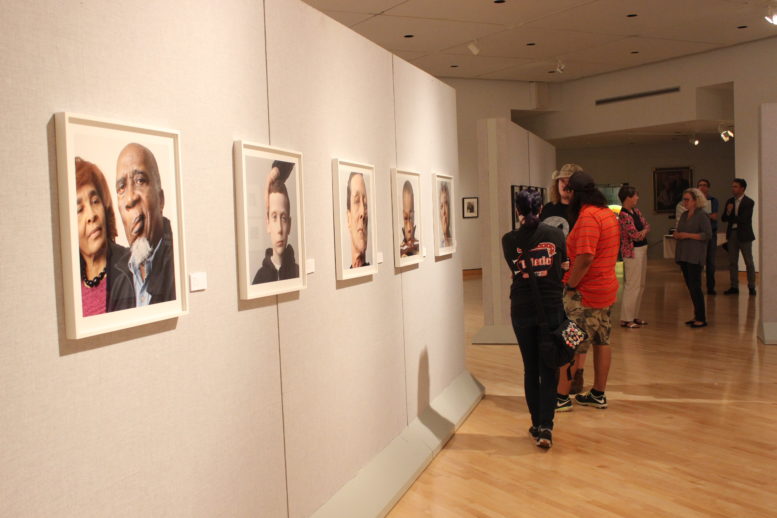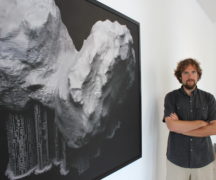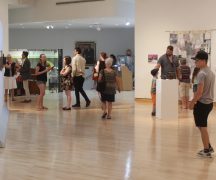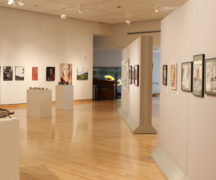By DAVID DUPONT
BG Independent News
Photographic portraits have always had their allure.
Think of those ghostly images staring back at you from 19th century daguerreotypes.
Viewers will find the contemporary descendants of those models in Face It: Reimagining Contemporary Portraits now on exhibit at the Bryan Gallery in the Fine Arts Building on the Bowling Green State University campus.
Recently this reporter was treated to a tour of the show accompanied by the three curators and two photographers who have work in the exhibit.
The seed for Face It was planted with a passing remark by Jacqui Nathan, the gallery director, to Lynn Whitney, who teaches photography at BGSU. How about a portrait show? Nathan asked. That casual suggestion took a couple years to gestate, but with the help of art historian Andrew Hershberger it has now come to fruition.
Photo portraits are “very common,” he said, “Very familiar.” We carry them around with us in our wallets, on our telephones. We have identification cards with portraits on them.
And we treasure them. In the event of a disaster, after family and pets are safe, people will grab the family portraits.
“Arguably this is most common type of photography ever,” he said. “Yet they remain mysterious.”
Back in the days of daguerreotypes, “people were frightened of these portraits,” Hershberger said. “The kind of impact portraits can have is pretty dramatic.”
That pull is evident in Face It, whether it is the tightly cropped images of photographer Nicholas Nixon and his wife, who in a couple images peers surreptitiously out at the viewer or Greg Miller’s photos of children waiting for the school bus in Connecticut. Those photos were taken near Sandy Hook not long after the horrific school shooting there.
Hershberger quotes Miller as saying: “How can anyone not see children, all children, as their own, as nieces and nephews, or even as themselves?”
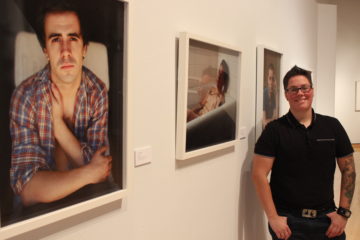
Jess Dugan poses near her work on display in Face It.
In putting together the show, the curators drew mostly on contemporary works with a few iconic images to set the stage. Three portraits on loan from the Toledo Museum of Art include a portrait of a pastry cook from 1928 by August Sander.
Sander’s work inspired that of Daniel McInnis, who teaches at BGSU. A Metropolitan Museum of Art retrospective of Sander’s Face of Our Time series, which included thousands of images, was “a leaping off point” for McInnis’ series of portraits of artists.
There is also a quartet of intimate images from Emmet Gowin of his wife and her sister and a photo by Andrea Modica of Derek Jeter taken during spring training before his rookie season.
“He’s a baby,” Whitney said looking at the image. Still, she noted, you can see the combination of strength and softness that would characterize the Yankee short stop throughout his 22-year career.
A nationally known photographer, Whitney knows many of the photographers whose work is represented. “Many these people here are my friends or friends of friends. This is personal, this show, for me.”
“It seems to me,” said Jess Dugan, a photographer whose work is represented in the show, “the pictures in this show are made by people who deeply believe in the power of portraiture, and deeply believe in the resonance of photographing another person, connecting with another person, and sharing that image.”
She continued: “There’s a bit of coldness and cynicism that’s in vogue in the art world at large. This to me is like a very sincere approach to image making and a sincere attempt on the part of photographers in the show to really connect with and understand their world and the world of other people through the act of making portraits.”
DONATE $10 A MONTH TO THE NEWSLast week, Dugan gave a talk on her work. In her early days she photographed people she knew in the LBGTQ community in the Boston area. The photos in the show come from this period. She showed the images she has taken every year of her mother and herself, their breasts bare. The first was created shortly after Dugan had breast reduction surgery.
Now, Dugan is working with her partner, and photographing transgender people, 50 years old and older. Some were pioneers, undergoing transition 40 or more years ago. One was of a woman who transitioned after the age of 80.
Unlike early in her career when she knew many of her subjects, Dugan traveled around the country photographing strangers. Or at least they were strangers at first.
“It’s really difficult for me to make a compelling portrait of someone that I don’t have some kind of respect and admiration for,” she said. “Especially with the people I don’t know previously, I feel really grateful that my camera acts as this reason to get to know them on a much deeper level. It gives me a specific reason to spend time with them look at them listen their stories.”
Afterward “it’s important for me to keep in touch.”
Once the image is made, and displayed, she said, the viewer “is standing exactly in my shoes and looking at it exactly the way I saw it.”
Among the most striking photos are Sage Sohier’s images of people with partial facial paralysis from stokes, Bell’s palsy or other conditions.
Whitney said some people assume that the images have been digitally manipulated.
All people posing for a portrait, Hershberger said, are in a “vulnerable position.” That’s particularly true of these people.
That vulnerability is true as well when photographers are themselves the subject, Dugan said. “I truly have to work my way to my own kind of emotional openness. …The self-portraits are a personal level, a way to understand myself and share my own story. That helps connect with other people and allows space for other people to be equally open with me.”
Face It continues through next Thursday, Oct. 6, at the gallery. From there, the show will travel to East Tennessee State University.

